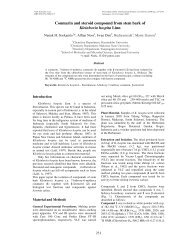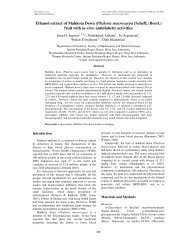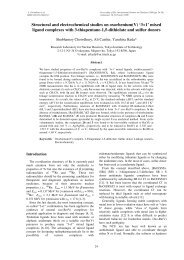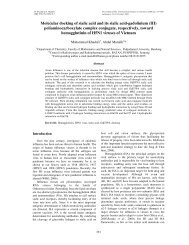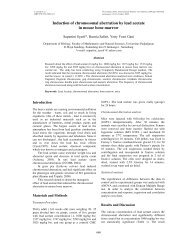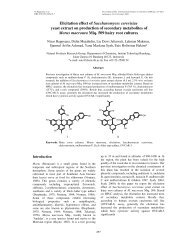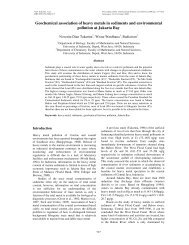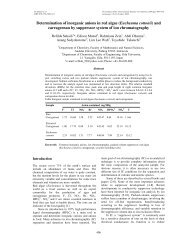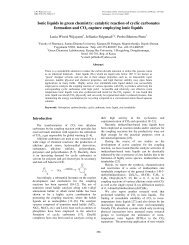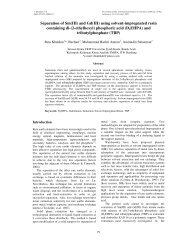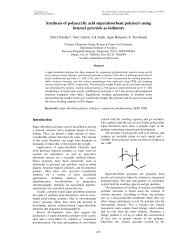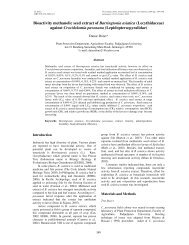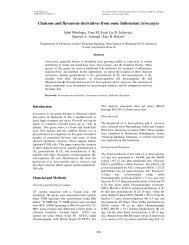Adsorption characteristics of Pb(II) onto C-4-Hydroxy-3 ...
Adsorption characteristics of Pb(II) onto C-4-Hydroxy-3 ...
Adsorption characteristics of Pb(II) onto C-4-Hydroxy-3 ...
Create successful ePaper yourself
Turn your PDF publications into a flip-book with our unique Google optimized e-Paper software.
R.E. Sardjono et al. Proceeding <strong>of</strong> The International Seminar on Chemistry 2008 (pp. 419-425)<br />
ISBN 978-979-18962-0-7<br />
Jatinangor, 30-31 October 2008<br />
<strong>Adsorption</strong> <strong>characteristics</strong> <strong>of</strong> <strong>Pb</strong>(<strong>II</strong>) <strong>onto</strong><br />
C-4-<strong>Hydroxy</strong>-3-methoxyphenylcalix[4]resorcinarene<br />
in batch and fixed bed column systems<br />
Ratnaningsih E. Sardjono 1 *, Jumina 2 , A. Wawan Nurwahidin 1 , Taufik 2 ,<br />
Hardjono Sastrohamidjojo 2 , Sri Juari Santosa 2<br />
1 Department <strong>of</strong> Chemistry Education, Faculty <strong>of</strong> Mathematics and Natural Sciences,<br />
Indonesia University <strong>of</strong> Education, Jl. Setiabudi 229Bandung<br />
2 Department <strong>of</strong> Chemistry, Faculty <strong>of</strong> Mathematics and Natural Sciences, Gadjah Mada University,<br />
Sekip Utara PO Box Bls. 21 Yogyakarta, Indonesia<br />
*e-mail: ratnaeksa@yahoo.com<br />
Abstract<br />
A study on the adsorption <strong>characteristics</strong> <strong>of</strong> <strong>Pb</strong>(<strong>II</strong>) cations <strong>onto</strong> C-4-hydroxy-3-<br />
methoxyphenylcalix[4]resorcinarene (CHMPCR) in batch and fixed bed column systems has been<br />
conducted. CHMPCR was produced by one step synthesis from resorcinol, vanillin (4-hydroxy-3-<br />
methoxybenzaldehyde), and HCl. The synthesis was carried out at 78 o C for 24 hours, and afforded<br />
the adsorbent in 96,9 % as a 2:1 mixture <strong>of</strong> C 4v : C 2v isomer. Most parameters in batch and fixed bed<br />
column systems confirm that CHMPCR is a good adsorbent for <strong>Pb</strong>(<strong>II</strong>). The adsorption kinetic <strong>of</strong><br />
<strong>Pb</strong>(<strong>II</strong>) adsorptions in batch and fixed bed column systems followed pseudo 2 nd order kinetics model.<br />
In addition, the adsorption equilibrium isotherm <strong>of</strong> <strong>Pb</strong>(<strong>II</strong>) adsorption in batch system followed<br />
Freundlich isotherm. <strong>Adsorption</strong> capacities <strong>of</strong> <strong>Pb</strong>(<strong>II</strong>) were 5.44 µmol/g (91,84%) in batch system and<br />
3.95 µmol/g in fixed bed column system. Desorption studies to recover the adsorbed <strong>Pb</strong>(<strong>II</strong>) were<br />
performed sequentially with distilled water and HCl, and the results showed that the adsorption was<br />
dominated by chemisorption.<br />
Key words: adsorption, <strong>Pb</strong>(<strong>II</strong>), C-4-hydroxy-3-methoxyphenylcalix[4]resorcinarene, batch system,<br />
fixed bed column system<br />
Introduction<br />
Heavy metals are common pollutant found in various<br />
industrial effluents. The strict environment regulation<br />
on the discharge <strong>of</strong> heavy metals has led to the<br />
necessity to develop various technologies for heavy<br />
metal removal. Waste streams containing low-tomedium<br />
level <strong>of</strong> heavy metals are <strong>of</strong>ten encountered<br />
in metal plating facilities, electroplating, mining<br />
operations, fertilizer, battery manufacture, dye stuffs,<br />
chemical pharmaceutical, electronic device<br />
manufactures, and many others. Most heavy metals<br />
are highly toxic and are not biodegradable; therefore<br />
they must be removed from the polluted streams in<br />
order to meet increasingly stringent environmental<br />
quality standards.<br />
Many methods including chemical precipitation,<br />
electro-deposition, ion-exchange, membrane<br />
separation, and adsorption have been used to treat<br />
industrial wastes. Traditional precipitation is the most<br />
economic but is inefficient for dilute solution. Ion<br />
exchange and reverse osmosis are generally effective,<br />
but have rather high maintenance and operation costs<br />
and subject to fouling. <strong>Adsorption</strong> is one <strong>of</strong> the few<br />
promising alternatives for this purpose, especially<br />
using low-cost natural adsorbents such as agricultural<br />
wastes (maize cob and husk 1 , ground pine cone 2 ),<br />
charcoal 3 , fly ash 4 , zeolite 5,6 , and granular activated<br />
carbon 7 . New synthetic adsorbents have also been<br />
developed in order to generate alternative materials<br />
having different properties compared to those <strong>of</strong><br />
natural materials.<br />
Calix[4]resorcinarenes are class <strong>of</strong> synthetic<br />
macromolecule having tetramer <strong>of</strong> resorcine residues<br />
in a cyclic array and linked by a methylene bridge.<br />
The macromolecules are obtained by acid-catalyzed<br />
condensation <strong>of</strong> resorcinol with a variety <strong>of</strong><br />
aldehydes. Calix[4]resorcinarenes represent an<br />
interesting family <strong>of</strong> structures which exhibit<br />
characteristic <strong>of</strong> cavity-shaped architecture. Various<br />
studies have illustrated their application as host<br />
molecules for various guests, such as cations, anions,<br />
and molecules. The family <strong>of</strong> calix[4]resorcinarenes<br />
has also been used for various functions, namely as an<br />
additive in capillary electrophoresis 8 , liquid<br />
membrane 9,10 , extraction 9 , chemical sensing 11,12 , and<br />
High Performance Liquid Chromatography (HPLC)<br />
stationary phase. However, the use <strong>of</strong><br />
calix[4]resorcinarenes as heavy metal cation<br />
adsorbent is still very limited.<br />
C-4-<strong>Hydroxy</strong>-3-Methoxyphenylcalix[4]resor-<br />
Cinarene (CHMPCR) is calix[4]resorcinarene which<br />
has eight benzene residues, twelve hydroxyl groups,<br />
and four methoxy groups (Fig 1). CHMPCR was syn-<br />
419
R.E. Sardjono et al. Proceeding <strong>of</strong> The International Seminar on Chemistry 2008 (pp. 419-425)<br />
Jatinangor, 30-31 October 2008<br />
HO<br />
OH<br />
H3CO<br />
+<br />
OH<br />
HCl, ethanol<br />
77 o C 15 h<br />
HO<br />
HO<br />
OCH 3<br />
HO<br />
OH<br />
OH<br />
OH<br />
OCH 3<br />
resorcinol<br />
O<br />
HO<br />
H 3<br />
vanilin<br />
CO<br />
HO<br />
HO<br />
Figure 1 Reaction Scheme <strong>of</strong> CHMPCR Synthesis<br />
OH<br />
OH<br />
OH<br />
OCH 3<br />
thesized in this research through acid-catalyzed<br />
condensation <strong>of</strong> resorcinol and vanillin (4-hydroxy-3-<br />
methoxybenzaldehyde). The presence <strong>of</strong> lone-pair<br />
electrons in the hydroxyl and methoxy groups, also π-<br />
electrons in the aromatic residues can be expected to<br />
exhibit <strong>characteristics</strong> affinities to heavy metal<br />
cations, especially <strong>Pb</strong>(<strong>II</strong>). The <strong>Pb</strong>(<strong>II</strong>) cation is<br />
considered to be a intermediate Pearson acid, while<br />
CHMPCR with its hydroxyl arms and aromatic rings<br />
can form both a “hard” and a “s<strong>of</strong>t” ion binding sites,<br />
respectively. Thus, it was <strong>of</strong> interest to investigate the<br />
interaction <strong>of</strong> CHMPCR with the <strong>Pb</strong>(<strong>II</strong>) heavy metal<br />
cations.<br />
Material and Methods<br />
Reagents<br />
Metal solutions were prepared by diluting 1000 mg/L<br />
<strong>Pb</strong>(NO 3 ) 2 standard solution in aqueous nitric acid to<br />
desired concentrations. An adjustment <strong>of</strong> pH was<br />
carried out by adding slowly NaOH and / or HNO 3<br />
solution(s) into the metal solutions followed by<br />
stirring until desired pH. Chemicals needed for<br />
synthesizing CHMPCR were resorcinol, vanillin,<br />
HCl, and ethanol. All materials required were reagent<br />
grade from E Merck.<br />
Instruments<br />
In this experiment, equipments involving a set <strong>of</strong><br />
reflux utilities, buchner funnels,<br />
1 H NMR<br />
spectrometer (Jeol JNM-AL300 FT NMR System,<br />
300 MHz), and FTIR spectrophotometer (Shimadzu<br />
FTIR 8201PC) were used for CMPCR synthesizing<br />
and characterization. Pump, glass column, stirrer,<br />
Atomic Absorption Spectrophotometer (AAS; Perkin<br />
Elmer Analyst-100), pH meter (Hanna), were used for<br />
adsorption experiment and determination <strong>of</strong> <strong>Pb</strong>(<strong>II</strong>)<br />
concentrations.<br />
Synthesis <strong>of</strong> CHMPCR<br />
Into a solution <strong>of</strong> resorcinol (0.55 g, 5 mmol) and<br />
vanillin (4-hydroxy-3-methoxybenzaldehyde (0.76 g,<br />
5 mmol) in 50 mL <strong>of</strong> 95% ethanol was added 0.5 mL<br />
<strong>of</strong> hydrochloric acid. The solution was stirred and<br />
refluxed at 78 o C for 15 hours. The product that<br />
separated was filtered. The solid was washed using<br />
ethanol-water repeatedly and then dried to give the<br />
desired compound as a light purple solid in 96.9%<br />
(1.18 g): mp > 390 o C (dec), 1 H NMR (300MHz,<br />
298K, DMSO) δ H : 8.44, 8.36, 8.35 and 7.85 (4 s,<br />
12H, ArOH), 6.43-6.08 (m, 20H, ArH), 5.45 and 5.40<br />
(2 s, 4H, CH methine), 4.39 (s, 12H, OCH 3 ).<br />
<strong>Adsorption</strong> Procedures<br />
Batch experiment was conducted by adding 0.06 g <strong>of</strong><br />
CHMPCR (its particle size was < 100 mesh) into 10<br />
mL <strong>of</strong> metal cation sample solution having<br />
concentration about 10 mg/L. The mixture was<br />
shaken at room temperature for certain period <strong>of</strong> time<br />
(1 h). The adsorbent was filtered out and dried in a<br />
desicator. Concentration <strong>of</strong> <strong>Pb</strong>(<strong>II</strong>) was then measured<br />
by AAS. The data obtained was compared and<br />
corrected by a blank solution. The blank solution was<br />
similar to the adsorption sample except for the<br />
existence <strong>of</strong> the adsorbent. The amount <strong>of</strong> metal<br />
cation adsorbed was calculated from the difference<br />
between the metal cation concentration before and<br />
after the adsorption experiment. The metal uptake, q<br />
(mg metal ion/g CHMPCR) was determined as<br />
follows:<br />
q = (C o -C) x V/m (1)<br />
Where C o and C are the initial and the final metal ion<br />
concentrations (mg/L), respectively; V is the volume<br />
<strong>of</strong> solution (mL); and m is the CHMPCR weight (g)<br />
in dry form. For each metal cation, the experiment<br />
was done in 3 conditions, i.e. variation <strong>of</strong> pH, shaking<br />
time, and adsorbent weight.<br />
The fixed bed column adsorption experiment was<br />
done in a descendant flow. The equipment used is<br />
depicted in Figure 13. The metal solutions were<br />
prepared by diluting 1000 mg/L metal cation standard<br />
solution in aqueous nitric acid to the desired<br />
concentration (10 mg/L). Adjustment <strong>of</strong> pH <strong>of</strong> the<br />
metal solutions was carried out by adding slowly<br />
NaOH and / or HNO 3 solutions followed by stirring<br />
until desired pH. This metal solution was passed<br />
through the column in a down flow at a fixed flow<br />
420
R.E. Sardjono et al. Proceeding <strong>of</strong> The International Seminar on Chemistry 2008 (pp. 419-425)<br />
Jatinangor, 30-31 October 2008<br />
rate (1 mL/min). The solution which passed through<br />
the column was fractionated into 5 cm 3 portions, and<br />
the effluent concentration was determined by AAS.<br />
Fractions <strong>of</strong> the effluent were collected until the ratio<br />
<strong>of</strong> effluent concentration (C) to initial concentration<br />
(Co) equals to one.<br />
The ratio <strong>of</strong> C/Co called as breakthrough was<br />
plotted against the volume <strong>of</strong> the solution passed in<br />
the column or against the time to obtain a<br />
breakthrough curve. The breakthrough time, t b , was<br />
determined as the time when C/Co was equal to 0.05.<br />
Desorption process was done sequentially. Metal<br />
adsorbed was eluted with water, followed by aqueous<br />
HCl solution at desired flow rate, and 5 mL <strong>of</strong><br />
fractions were collected. Elution for each desorption<br />
agent was conducted until the effluent metal<br />
concentration equals to the influent metal<br />
concentration.<br />
Results and Discussions<br />
Synthesis and Characterization <strong>of</strong> CHMPCR<br />
The synthesis <strong>of</strong> CHMPCR went lovely, easily, and<br />
consumed low-cost. The product separated from the<br />
reaction mixture at the early minutes <strong>of</strong> reaction and<br />
gave abundance yields as white precipitates. The<br />
structure <strong>of</strong> CHMPCR was confirmed by proton<br />
Nuclear Magnetic Resonance ( 1 H NMR) and Fourier<br />
Transform Infrared (FTIR) spectrometers. It was<br />
interesting to note that each signal group in the 1 H<br />
NMR spectrum emerged as couple <strong>of</strong> signals having<br />
ratio <strong>of</strong> 2:1. This fact is in accordance with the<br />
findings <strong>of</strong> previous workers 13-16 who found that the<br />
products <strong>of</strong> condensation between resorcinol and<br />
aromatic aldehydes were only tetrameric<br />
resorcinarenes, and out <strong>of</strong> four diastereoisomeric<br />
products that could theoretically be formed, only two<br />
diastereoisomers which were obtained in reality, i.e.<br />
C 4v (rccc, crown) and C 2v (rctt, chair). Ratio <strong>of</strong> C 4v<br />
and C 2v isomeric products varies with the reaction<br />
time and temperature.<br />
The interpretation <strong>of</strong> chemical shifts and the<br />
ratios <strong>of</strong> the amount <strong>of</strong> the isomers formed were<br />
determined through comparison between the proton<br />
NMR spectrum <strong>of</strong> the synthesized CHMPCR and<br />
those <strong>of</strong> the C 4v and C 2v isomers from reactions<br />
products <strong>of</strong> benzaldehyde and resorcinol which have<br />
been separated and fully characterized by previous<br />
worker 14 . The two <strong>of</strong> CHMPCR isomers were<br />
identified by four <strong>of</strong> single peaks for the ArOH (δ H =<br />
8.44, 8.36, 8.35 and 7.85) having total integration<br />
4.627 according to 12 H, <strong>characteristics</strong> multiplet<br />
signal for the ArH (δ H = 6.43-6.08) having total<br />
integration 12.438 or 20 H, the two <strong>of</strong> singlet the<br />
bridging methine proton signal represent two isomers<br />
<strong>of</strong> CHMPCR (δ H = 5.45 (C 4v ) and 5.40 (C 2v )). Their<br />
signals have total integration 1.542 according to 4H,<br />
and having ratio integration C 4v and C 2v isomers 2:1.<br />
Finally, a singlet peak for OCH 3 present at δ H = 4.39<br />
and have integration 4.337 according to 12H.<br />
Interestingly, the crown isomer (C 4v ) <strong>of</strong><br />
CHMPCR was present in higher amount compared to<br />
the chair isomer (C 2v ). Hydrogen bonds occurring<br />
between adjacent hydroxyl groups and the existence<br />
<strong>of</strong> staggered phenyl groups apparently stabilize the<br />
rccc crown conformers. In order to avoid a high-cost<br />
adsorbent production, the isomeric mixture <strong>of</strong><br />
CHMPCR was used directly in the metal adsorption<br />
experiment.<br />
The FTIR spectrum <strong>of</strong> CHMPCR showed<br />
<strong>characteristics</strong> absorption at 3414 cm -1 due to O-H<br />
stretching vibration. It is well known that absorption<br />
bands <strong>of</strong> O-H stretching vibrations, when free, appear<br />
at around 3600 cm -1 , and a hydrogen bonding causes<br />
these bands to shift to the lower frequencies. The<br />
weak frequencies at 2974-2927 cm -1 are<br />
corresponding to CH stretching frequencies. In<br />
addition, the IR spectrum also displayed a<br />
significantly intense C-C aromatic streching<br />
frequencies at 1612 and 1515 cm -1 , CH 3 bending at<br />
1375 cm -1 and C-O-C stretching frequency at 1207<br />
cm -1 .<br />
Batch System<br />
Effect <strong>of</strong> pH<br />
The effect <strong>of</strong> pH on the adsorptions <strong>of</strong> <strong>Pb</strong>(<strong>II</strong>) by<br />
CHMPCR was studied in the pH range <strong>of</strong> 2 to 5 with<br />
the initial concentration <strong>of</strong> metal solution <strong>of</strong> about 10<br />
mg/L and the results are shown in Figure 1. The<br />
amount <strong>of</strong> <strong>Pb</strong>(<strong>II</strong>) adsorbed consistently increased by<br />
the increase <strong>of</strong> initial pH, and it reached optimum<br />
value (4.64 µmol/g or 68.42 % in percentage) at<br />
initial pH value <strong>of</strong> 4.<br />
<strong>Pb</strong>(<strong>II</strong>) adsorbed (%)<br />
80<br />
70<br />
60<br />
50<br />
40<br />
30<br />
20<br />
10<br />
0<br />
0 2 initial pH 4 6<br />
Figure 2 Effect <strong>of</strong> pH on the adsorptions <strong>of</strong> <strong>Pb</strong>(<strong>II</strong>)<br />
<strong>onto</strong> CHMPCR<br />
The fact that the amount <strong>of</strong> metal cation adsorbed<br />
at low pH was only little apparently was caused by<br />
the occurrence <strong>of</strong> protonation <strong>of</strong> most donating<br />
groups, especially OH groups, <strong>of</strong> CHMPCR. It was<br />
envisaged that the interaction between CHMPCR and<br />
<strong>Pb</strong>(<strong>II</strong>) cation involved an interaction between oxygen<br />
lone pair electrons and metal cation vacant orbitals.<br />
As the amount <strong>of</strong> H + at low pH was sufficiently<br />
excessive in comparison to that <strong>of</strong> metal cation, most<br />
421
R.E. Sardjono et al. Proceeding <strong>of</strong> The International Seminar on Chemistry 2008 (pp. 419-425)<br />
Jatinangor, 30-31 October 2008<br />
<strong>of</strong> oxygen pair electrons perhaps did coordinate with<br />
H + and not with metal cation. The size <strong>of</strong> H + , which is<br />
much smaller than that <strong>of</strong> metal cation, apparently<br />
also assisted the occurrence <strong>of</strong> interaction between<br />
oxygen pair electron <strong>of</strong> CHMPCR and H + . When the<br />
initial pH was sufficiently high (about 4), there was<br />
only limited amount <strong>of</strong> H + available in the system.<br />
Accordingly, the interaction occurred in the system<br />
was dominated by the interaction between oxygen<br />
lone pair electron <strong>of</strong> CHMPCR and metal cation<br />
vacant orbital. This is the reason why the amount <strong>of</strong><br />
metal adsorbed at relatively high pH value was<br />
significantly high. However, increasing initial pH to a<br />
value higher than 5.0 is not a good idea as there has<br />
been decreation <strong>of</strong> adsorption capacity.<br />
Effect <strong>of</strong> Contact Time<br />
The result <strong>of</strong> <strong>Pb</strong>(<strong>II</strong>) adsorptions at optimum pH with<br />
an increase <strong>of</strong> contact time is presented in Figure 3. It<br />
was found that initially the metal uptake increased as<br />
the contact time increased. The graph indicates that<br />
the <strong>Pb</strong>(<strong>II</strong>) adsorption took place quickly at the early<br />
minutes <strong>of</strong> interaction until approximately 6 minutes<br />
giving the amount <strong>of</strong> <strong>Pb</strong>(<strong>II</strong>) adsorbed as much as<br />
91.84 % (4.7 µmol/g). It then decreased slowly as the<br />
interaction time was extended until reached its<br />
constant adsorption value <strong>of</strong> 87.76 % (4.49 µmol/g) at<br />
minute <strong>of</strong> 60. After interaction process took place<br />
during 180 minutes, the amount <strong>of</strong> <strong>Pb</strong>(<strong>II</strong>) adsorbed<br />
did not change. <strong>Adsorption</strong> process at this point has<br />
reached equilibrium between the adsorbed metal ions<br />
and the free ions in solution.<br />
P b(<strong>II</strong>) adsorbed (% )<br />
100<br />
80<br />
60<br />
40<br />
20<br />
0<br />
0 50 100 150<br />
Time (minute)<br />
Figure 3 Effect <strong>of</strong> contact time on the adsorptions <strong>of</strong><br />
<strong>Pb</strong>(<strong>II</strong>) <strong>onto</strong> CHMPCR<br />
<strong>Adsorption</strong> Kinetics<br />
The experimental data <strong>of</strong> contact time effect on the<br />
adsorptions <strong>of</strong> <strong>Pb</strong>(<strong>II</strong>) were used for kinetic modeling.<br />
The model equations used for fitting the data were:<br />
pseudo 1 st order (Lagergren) and pseudo 2 nd order.<br />
The correlation coefficient (R 2 ) resulted from linear<br />
plot <strong>of</strong> log (q e -q) versus t, and t/q versus t are shown<br />
in Table 1. The adsorption rate constant (k) was<br />
calculated using slope or intercept values from the<br />
equation, where q e and q (both in mmol g -1 ) are the<br />
amounts <strong>of</strong> metal ion adsorbed (metal uptake) at<br />
equilibrium and at time t (min), respectively.<br />
Table 1 Kinetic model for <strong>Pb</strong>(<strong>II</strong>) adsorptions by<br />
CHMPCR in Batch System<br />
Kinetic Model R 2<br />
pseudo1 st order (Lagergren) equation<br />
log(q e -q)= log q e -(k/2.303)t<br />
0.6552<br />
Pseudo 2 nd order equation t/q<br />
= ½ kq 2 e + t/q e<br />
0.9999<br />
Based on the linear regression values, the<br />
kinetics <strong>of</strong> <strong>Pb</strong>(<strong>II</strong>) adsorptions <strong>onto</strong> CHMPCR could<br />
be described well by pseudo 2 nd order equation. Thus,<br />
it appeared that pseudo 2 nd order was the most valid<br />
kinetics model.<br />
Effect <strong>of</strong> Adsorbate Concentration<br />
Figure 4 shows the effect <strong>of</strong> adsorbate concentrations<br />
on adsorptions <strong>of</strong> <strong>Pb</strong>(<strong>II</strong>) <strong>onto</strong> CHMPCR. The amount<br />
<strong>of</strong> <strong>Pb</strong>(<strong>II</strong>) adsorbed consistently increased as the<br />
adsorbent weight increased, and it reached maximum<br />
(5.44 µmol/g) at initial adsorbate concentration <strong>of</strong><br />
7.92 mg/L, but this value wasn’t the optimum value.<br />
<strong>Pb</strong>(<strong>II</strong>) adsorbed (umol/g)<br />
6<br />
5<br />
4<br />
3<br />
2<br />
1<br />
0<br />
0 2 4 6 8 10<br />
Initial <strong>Pb</strong> (<strong>II</strong>) Concentrantion (mg/L)<br />
Figure 4 Effect <strong>of</strong> adsorbate concentration on <strong>Pb</strong>(<strong>II</strong>)<br />
adsorption <strong>onto</strong> CHMPCR<br />
<strong>Adsorption</strong> Isotherms<br />
The equilibrium data in the adsorbtion <strong>of</strong> <strong>Pb</strong>(<strong>II</strong>) and<br />
Cr(<strong>II</strong>I) <strong>onto</strong> CHMPCR were analyzed by using<br />
Freundlich and Langmuir isotherms, i.e. log q e = log<br />
K + 1/n log C e and 1/q e = 1/(K q o .C e ) + 1/q o ,<br />
respectively, where q e is the amount adsorbed at<br />
equilibrium (µmol/g), C e is the solution concentration<br />
at equilibrium (µmol/L), q o (µmol/g ) is the maximum<br />
capacity <strong>of</strong> adsorption, and K is the adsorption<br />
constant. The results <strong>of</strong> linear plots <strong>of</strong> log C e versus<br />
log q e (Freundlich model) and 1/q e versus 1/C e<br />
(Langmuir model) are shown in Table 2. The K<br />
values could be calculated from the slopes and<br />
intercepts.<br />
The data on Table 2 shows high values <strong>of</strong><br />
correlation coefficients (R 2 ) indicating linear<br />
relationships, but R 2 value <strong>of</strong> Freundlich isotherm was<br />
the best. The R 2 values <strong>of</strong> <strong>Pb</strong>(<strong>II</strong>) adsorption were<br />
0.9559 and 0.9110 for Freundlich and Langmuir<br />
models, respectively.<br />
422
R.E. Sardjono et al. Proceeding <strong>of</strong> The International Seminar on Chemistry 2008 (pp. 419-425)<br />
Jatinangor, 30-31 October 2008<br />
Table 2 Estimated isotherm model for and <strong>Pb</strong>(<strong>II</strong>)<br />
adsorptions<br />
Isotherm Model Linier equation R 2<br />
Freundlich y=4.3689x+4.7224 0.9559<br />
Langmuir Y=0.4081x-3.3879 0.9110<br />
Fixed Bed Column System<br />
The percentage <strong>of</strong> metal adsorbed in fixed bed<br />
column system is shown in Figure 6. <strong>Pb</strong>(<strong>II</strong>) was<br />
adsorbed completely (about 100%) at some early<br />
fractions until about 3 fractions. This fact showed that<br />
CHMPCR can be a good adsorbent for <strong>Pb</strong>(<strong>II</strong>). In the<br />
next fractions, percent <strong>of</strong> <strong>Pb</strong>(<strong>II</strong>) adsorbed decreased<br />
until the column exhausted, i.e. when the effluent<br />
concentration equals to influent concentration. This<br />
exhausted column took place since 14 th fraction.<br />
The breakthrough curve <strong>of</strong> <strong>Pb</strong>(<strong>II</strong>) adsorption is<br />
presented in Figure 5. It can be seen that 5%<br />
breakthrough point (BT), 50% BT, and 100% BT<br />
occurred after passing <strong>of</strong> the feeding solution <strong>of</strong> about<br />
15, 22 and 75 mL or about 12,5 ; 18 and 62,5 bed<br />
volume (BV), respectively.<br />
The column test also showed that the total uptake <strong>of</strong><br />
<strong>Pb</strong>(<strong>II</strong>) (q e ) was 3.95 µmol/g atau 0.46 mg <strong>Pb</strong>(<strong>II</strong>) per g<br />
<strong>of</strong> CHMPCR (Figure 7). This value <strong>of</strong> adsorption<br />
column capacity was significantly lower compared to<br />
the value <strong>of</strong> adsorption capacity in batch system that<br />
has maximum capacity about 5.44 µmol/g. The initial<br />
breakthrough occurred at column loading <strong>of</strong> about<br />
0.46 mg/g (q b ). This means that the amount <strong>of</strong> <strong>Pb</strong>(<strong>II</strong>)<br />
adsorbed has reached 56.7% <strong>of</strong> the total uptake,<br />
although <strong>Pb</strong>(<strong>II</strong>) solution applied was only 18.8% <strong>of</strong><br />
total volume, or 81.2% operating cost would be<br />
consumed for taking 44.3% <strong>of</strong> the rest <strong>of</strong> <strong>Pb</strong>(<strong>II</strong>).<br />
Likewise, at C/Co = 0.5, the amount <strong>of</strong> <strong>Pb</strong>(<strong>II</strong>)<br />
adsorbed reached almost 70%, i.e. 0.57 mg/g, and<br />
consumed as much as 25% <strong>of</strong> operating cost.<br />
Kinetic Aspect<br />
The kinetics <strong>of</strong> <strong>Pb</strong>(<strong>II</strong>) adsorptions present a shape<br />
characterized by strong capacity adsorption during the<br />
first few minutes <strong>of</strong> contact, followed by slow<br />
increase until state <strong>of</strong> equilibrium was reached. As an<br />
approximation, the removal <strong>of</strong> cations can be said to<br />
take place in two distinct steps: a relatively fast phase<br />
followed by a slower one.<br />
Kinetics <strong>of</strong> adsorption can be modeled by the<br />
pseudo first order Lagergren equation, and the pseudo<br />
second order rate equation. The results <strong>of</strong> linear plots<br />
<strong>of</strong> log (q e -q t ) versus t, t/q t versus t, and 1/(q e -q t ) versus<br />
t are shown in Table 3. The rate constant (k) values<br />
can be calculated from the slopes or intercepts<br />
according to its equation. According to the data in the<br />
table, the pseudo second-order reaction rate model<br />
adequately described the kinetics <strong>of</strong> <strong>Pb</strong>(<strong>II</strong>)<br />
adsorptions with the highest correlation coefficient.<br />
Tabel 3 Kinetic model for <strong>Pb</strong>(<strong>II</strong>) adsorptions by<br />
CHMPCR in Batch System<br />
Model kinetika<br />
Pseudo orde kesatu (Lagergren)<br />
Log (q e -q t ) = log q e - kt<br />
Pseudo orde kedua (Ho)<br />
t/q t = 1/2kq 2 e + t/q e<br />
R 2<br />
0.9525<br />
0.9868<br />
C/Co<br />
1.8<br />
1.6<br />
1.4<br />
1.2<br />
1.0<br />
0.8<br />
0.6<br />
0.4<br />
0.2<br />
0.0<br />
100% BT<br />
5% BT<br />
C/Co<br />
q<br />
50% BT<br />
t h<br />
t b<br />
0<br />
0 20 40 60 80 100<br />
Volume Efluen (mL)<br />
Figure 5. Breakthrough curve adsorption <strong>Pb</strong>(<strong>II</strong>) <strong>onto</strong> CHMPCR<br />
t e<br />
q e<br />
q h<br />
q b<br />
0.9<br />
0.8<br />
0.7<br />
0.6<br />
0.5<br />
0.4<br />
0.3<br />
0.2<br />
0.1<br />
Kapasitas Adsorpsi, q (mg/g)<br />
423
R.E. Sardjono et al. Proceeding <strong>of</strong> The International Seminar on Chemistry 2008 (pp. 419-425)<br />
Jatinangor, 30-31 October 2008<br />
0.9<br />
0.8<br />
0.7<br />
0.6<br />
0.5<br />
0.4<br />
0.3<br />
0.2<br />
0.1<br />
0<br />
adsorption<br />
desorption by waterr<br />
desorption by HCl<br />
0 50 100 150<br />
Volume (mL)<br />
Figure 6 Desorption sequential <strong>of</strong> <strong>Pb</strong>(<strong>II</strong>) on CHMPCR<br />
Desorption<br />
Desorption test was done sequentially to leach heavy<br />
metal cations which have been adsorbed <strong>onto</strong><br />
CHMPCR. This experiment was conducted to recover<br />
the column and to estimate the types <strong>of</strong> adsorption<br />
mechanism, hence different solutions was eluted to<br />
the column. The principle <strong>of</strong> this model is the usage<br />
<strong>of</strong> different desorption agents which have desorption<br />
ability that increased sequentially, i.e. (1) desorption<br />
by water to confirm adsorption mechanism physically<br />
(entrapment), (2) desorption by acid solution (HCl),<br />
which was used to leach metal cation adsorbed by<br />
chemical adsorption via ion exchange or hydrogen<br />
bond mechanism.<br />
The result <strong>of</strong> <strong>Pb</strong>(<strong>II</strong>) desorption is performed in<br />
Figure 6. According to the graph, water leached <strong>Pb</strong>(<strong>II</strong>)<br />
about 33.58%, whereas 1 M HCl solution leached<br />
<strong>Pb</strong>(<strong>II</strong>) completely, up to 99.5%. Based on the data,<br />
<strong>Pb</strong>(<strong>II</strong>) adsorption by CHMPCR was dominated by<br />
chemisorption (more than 66%), but physisorption<br />
ruled adsorption mechanism in moderate portion<br />
(about 33%).<br />
Conclusions<br />
CHMPCR was produced by one step synthesis from<br />
resorcinol, vanillin (4-hydroxy-3-<br />
methoxybenzaldehyde), and HCl. The synthesis was<br />
carried out at 78 o C for 24 hours, and afforded the<br />
adsorbent in 96,9 % as a 2:1 mixture <strong>of</strong> C 4v : C 2v<br />
isomer. Most parameters in batch and fixed bed<br />
column systems confirm that CHMPCR is a good<br />
adsorbent for <strong>Pb</strong>(<strong>II</strong>). The adsorption kinetic <strong>of</strong> <strong>Pb</strong>(<strong>II</strong>)<br />
adsorptions in batch and fixed bed column systems<br />
followed pseudo 2 nd order kinetics model. In addition,<br />
the adsorption equilibrium isotherm <strong>of</strong> <strong>Pb</strong>(<strong>II</strong>)<br />
adsorption in batch system followed freundlich<br />
isotherm. <strong>Adsorption</strong> capacities <strong>of</strong> <strong>Pb</strong>(<strong>II</strong>) were 5.55<br />
µmol/g (91.84%) in batch system and 3.95 µmol/g in<br />
fixed bed column system. Desorption studies showed<br />
that the adsorption was dominated by chemisorption.<br />
Acknowledgements<br />
The authors deeply thank to the State Ministry for<br />
Research and Technology <strong>of</strong> the Republic <strong>of</strong><br />
Indonesia who has provided financial support for this<br />
research through its International Joint Research<br />
Program (RUTI) and Rector <strong>of</strong> Indonesia University<br />
<strong>of</strong> Education who has provides financial support for<br />
this research through its UPI Competitive Grant.<br />
References<br />
1 Igwe, J.C.; Ogunewe, D.N.; Abia, A.A., Afr. J.<br />
Biotechnol. 2005, 10, 1113-1116.<br />
2 Izanloo H.; Nasseri,S., Iranian J. Env. Health Sci.<br />
Eng. 2005, 2, 33-42.<br />
3 Qadeer, R., J. Zhejiang Univ. SCI 2005, 5, 353-356.<br />
4 Li, Z.; Sun, X.; Luo, J.; Hwang, J.-Y., J. Min. & Mat.<br />
Char. & Eng. 2002, 1, 79-96.<br />
5 Barros, M.A.S.D.; Zola, A.S.; Arroyo, P.A.; Sousa-<br />
Agular, E.F.; Tavares, C.R.G., Acta Scientarium<br />
2002, 6, 1619-1625.<br />
6 Barros, M.A.S.D.; Zola, A.S.; Arroyo, P.A.; Sousa-<br />
Agular, E.F.; Tavares, C.R.G., Braz, J. Chem.<br />
Eng. 2003, 20, 4.<br />
7 Dianati-Tilaki, R.A.; Mahmood, S., Pak. J. Biol. Sci.,<br />
2004, 5, 865-869.<br />
8 Britz-Mckibbin, P.; Chen, D.D.-Y., , Anal.<br />
Chem.1998, 70, 907-912.<br />
9 Jain, V.K.; Pillai, S.G.; Pandya, R.A.; Agrawal,<br />
Y.K.; Shrivastav, P.S., Anal. Sci. 2005, 21, 129-<br />
135.<br />
10 Mustafina, A.R.; Skripacheva, V.V.; Fedorenko,<br />
S.V.; Kazakova, E.K.; Konovalov, A.I., Butlerov<br />
Comm. 2000, 3.<br />
11 Wei, A.; Kim, B.; Pusztay, S.V.; Tripp, S.L.;<br />
Balasubramanian, R.; J. Incl. Phen. & Macrocyc.<br />
Chem. 2001, 41, 83-86.<br />
12 Pietraszkiewicz, M.; Pietraszkiewicz, O; Uzig, E.;<br />
Prus, P.; Brzozka, Z.; Woniak, K.; Bilewiez, R.;<br />
Borowiaak, T.; Czynski, M.M., Butlerov Comm.<br />
424
R.E. Sardjono et al. Proceeding <strong>of</strong> The International Seminar on Chemistry 2008 (pp. 419-425)<br />
Jatinangor, 30-31 October 2008<br />
2000, 3. Available on website<br />
http://chem.kstu.ru/JCHEM&CS/English/n3/sm3<br />
/sm3.htm<br />
13 Barrett, A.G.; Braddock, D.C.; Henschke, J.P.;<br />
Waalker, E.R.; J. Chem. Soc., Perkin Trans I<br />
1999, 873-878.<br />
14 Tunstad, L.M; Tucker, J.A.; Daicanale, E.; Weiser,<br />
J.; Bryant, J.A.; Sherman, J.C.; Helgeson, R.C.;<br />
Knobler, C.B.; Cram, D.J., J. Org. Chem. 1989,<br />
54, 6, 1305-1312.<br />
15 Roberts, B.A.; Cave, G.W.V.; Raston, C.L.; Scott,<br />
J.L., Green Chem. 2001, 3, 280-284.<br />
16 Yamakawa, Y.; Ueda, M.; Nagahata, R.; Takeuchi,<br />
K.; Asai, M., J. Chem. Soc., Perkin Trans 1<br />
1998, 4135-4139.<br />
17 Manna, B.; Dasgupta, M.; Ghosh, U.C., J. Water<br />
Supply: Research & Tech-AQUA 2004, 7, 483-<br />
495.<br />
18 T<strong>of</strong>an, L.; Paduraru, C., Croat. Chem. Acta 2004, 4,<br />
581-586.<br />
19 Goswani, S.; Ghosh, U.C., Water SA 2005, 31, 597-<br />
602.<br />
425



